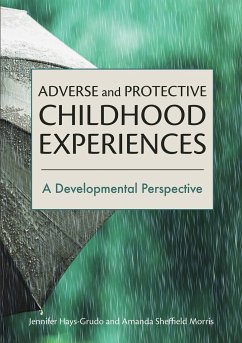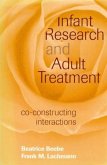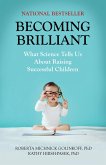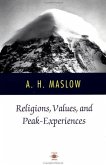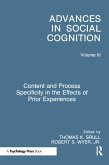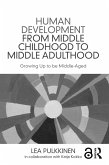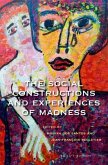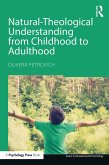Jennifer Hays-Grudo, Amanda Sheffield Morris
Adverse and Protective Childhood Experiences
A Developmental Perspective
Jennifer Hays-Grudo, Amanda Sheffield Morris
Adverse and Protective Childhood Experiences
A Developmental Perspective
- Broschiertes Buch
- Merkliste
- Auf die Merkliste
- Bewerten Bewerten
- Teilen
- Produkt teilen
- Produkterinnerung
- Produkterinnerung
This book provides an interdisciplinary lens from which to view the multiple types of effects of enduring childhood experiences, and to recommend evidence-based approaches for protecting and buffering children and repairing the negative consequences of ACEs as adults.
Andere Kunden interessierten sich auch für
![Infant Research and Adult Treatment Infant Research and Adult Treatment]() Beatrice BeebeInfant Research and Adult Treatment73,99 €
Beatrice BeebeInfant Research and Adult Treatment73,99 €![Becoming Brilliant Becoming Brilliant]() Roberta Michnick GolinkoffBecoming Brilliant24,99 €
Roberta Michnick GolinkoffBecoming Brilliant24,99 €![Religions, Values, and Peak-Experiences Religions, Values, and Peak-Experiences]() Abraham H. MaslowReligions, Values, and Peak-Experiences24,99 €
Abraham H. MaslowReligions, Values, and Peak-Experiences24,99 €![Content and Process Specificity in the Effects of Prior Experiences Content and Process Specificity in the Effects of Prior Experiences]() Content and Process Specificity in the Effects of Prior Experiences75,99 €
Content and Process Specificity in the Effects of Prior Experiences75,99 €![Human Development from Middle Childhood to Middle Adulthood Human Development from Middle Childhood to Middle Adulthood]() Lea PulkkinenHuman Development from Middle Childhood to Middle Adulthood82,99 €
Lea PulkkinenHuman Development from Middle Childhood to Middle Adulthood82,99 €![The Social Constructions and Experiences of Madness The Social Constructions and Experiences of Madness]() The Social Constructions and Experiences of Madness72,99 €
The Social Constructions and Experiences of Madness72,99 €![Natural-Theological Understanding from Childhood to Adulthood Natural-Theological Understanding from Childhood to Adulthood]() Olivera PetrovichNatural-Theological Understanding from Childhood to Adulthood59,99 €
Olivera PetrovichNatural-Theological Understanding from Childhood to Adulthood59,99 €-
-
-
This book provides an interdisciplinary lens from which to view the multiple types of effects of enduring childhood experiences, and to recommend evidence-based approaches for protecting and buffering children and repairing the negative consequences of ACEs as adults.
Hinweis: Dieser Artikel kann nur an eine deutsche Lieferadresse ausgeliefert werden.
Hinweis: Dieser Artikel kann nur an eine deutsche Lieferadresse ausgeliefert werden.
Produktdetails
- Produktdetails
- Verlag: American Psychological Association (APA)
- Seitenzahl: 236
- Erscheinungstermin: 24. März 2020
- Englisch
- Abmessung: 251mm x 178mm x 15mm
- Gewicht: 431g
- ISBN-13: 9781433832116
- ISBN-10: 1433832119
- Artikelnr.: 58021425
- Herstellerkennzeichnung
- Libri GmbH
- Europaallee 1
- 36244 Bad Hersfeld
- 06621 890
- Verlag: American Psychological Association (APA)
- Seitenzahl: 236
- Erscheinungstermin: 24. März 2020
- Englisch
- Abmessung: 251mm x 178mm x 15mm
- Gewicht: 431g
- ISBN-13: 9781433832116
- ISBN-10: 1433832119
- Artikelnr.: 58021425
- Herstellerkennzeichnung
- Libri GmbH
- Europaallee 1
- 36244 Bad Hersfeld
- 06621 890
Jennifer Hays-Grudo, Ph.D, is a Regents Professor of Psychiatry and Behavioral Science, Oklahoma State University. Dr. Hays-Grudo received both her master's and doctorate in developmental psychology from the University of Houston and her bachelor's in psychology from Texas Tech University. She has participated as the principal investigator on a number of National Institutes of Health-funded research grants to develop and evaluate individual and community health-related behavior changes. Amanda Sheffield Morris, PhD, is a Regents Professor of Human Development and Family Science, Oklahoma State University. She received her PhD from Temple University in Psychology, was a post-doctoral fellow at Arizona State University, and taught at the University of New Orleans for five years. Her research focuses on the role of emotion regulation in child and adolescent adjustment and the ways in which children learn successful regulation skills.
Preface: The Hole in the Bridge
Acknowledgements
I. The Effects of Adverse and Protective Childhood Experiences
1. Adverse Childhood Experiences
The Adverse Childhood Experiences Study
ACEs Studies in Other Populations
ACEs in Children and Adolescents
Defining ACEs
Knowing One’s ACE Score
2: Protective and Compensatory Experiences: The Antidote to ACEs
PACEs: Relationships and Resources
PACEs Foundational Theories and Research
Our Research on PACEs
Knowing One’s PACE Score
Part II. How Early Experience Influences the Body, Brain, and Behavior
3. Effects of Early Life Adversity on Neurobiological Development
Models of Biobehavioral Responses to Childhood Adversity
Epigenetics and Childhood Adversity
Effects of Childhood Adversity on Brain Structure and Function
Putting It All Together: The ICARE Model
4. The Intergenerational Transmission of ACEs and PACEs
Psychosocial Transmission of Adversity and Resilience
Neurobiological Transmission of Parenting
Neurobiological Transmission of Adversity and Resilience
Conclusions and Activity: ACEs and PACEs Genograms
III. Breaking the Cycle of ACEs and Increasing PACEs
5. Repairing the Effects of ACEs in Adulthood
ACE-Based Science as a Foundation for Interventions
PACEs for Adults
Conclusions and Activity: Creating an Adult PACEs Plan
6. Promoting Positive Development in Children with ACEs
PACEs for Children
PACEs for Adolescents
Enhancing Neurobiological Regulation
Fostering Positive Caregiver–Child Relationships
Systems-Level Programs
Conclusions and Activity: Creating a Child PACEs Plan
7. ACEs and PACEs and Communities
The Historical and Social Context of ACEs
Trauma-Informed Practices
Community Coalitions Focused on ACEs and Resilience
Policy Change and Legislation
Adverse Community Environments and Adverse Childhood Experiences: A Pair of
ACEs
8: Putting It All Together: Summary and Solutions
What We Have Learned
Solutions—What to Do Next
Finding A Life Raft
Appendix: Questions for Reflection
Resources
References
Index
About the Authors
Acknowledgements
I. The Effects of Adverse and Protective Childhood Experiences
1. Adverse Childhood Experiences
The Adverse Childhood Experiences Study
ACEs Studies in Other Populations
ACEs in Children and Adolescents
Defining ACEs
Knowing One’s ACE Score
2: Protective and Compensatory Experiences: The Antidote to ACEs
PACEs: Relationships and Resources
PACEs Foundational Theories and Research
Our Research on PACEs
Knowing One’s PACE Score
Part II. How Early Experience Influences the Body, Brain, and Behavior
3. Effects of Early Life Adversity on Neurobiological Development
Models of Biobehavioral Responses to Childhood Adversity
Epigenetics and Childhood Adversity
Effects of Childhood Adversity on Brain Structure and Function
Putting It All Together: The ICARE Model
4. The Intergenerational Transmission of ACEs and PACEs
Psychosocial Transmission of Adversity and Resilience
Neurobiological Transmission of Parenting
Neurobiological Transmission of Adversity and Resilience
Conclusions and Activity: ACEs and PACEs Genograms
III. Breaking the Cycle of ACEs and Increasing PACEs
5. Repairing the Effects of ACEs in Adulthood
ACE-Based Science as a Foundation for Interventions
PACEs for Adults
Conclusions and Activity: Creating an Adult PACEs Plan
6. Promoting Positive Development in Children with ACEs
PACEs for Children
PACEs for Adolescents
Enhancing Neurobiological Regulation
Fostering Positive Caregiver–Child Relationships
Systems-Level Programs
Conclusions and Activity: Creating a Child PACEs Plan
7. ACEs and PACEs and Communities
The Historical and Social Context of ACEs
Trauma-Informed Practices
Community Coalitions Focused on ACEs and Resilience
Policy Change and Legislation
Adverse Community Environments and Adverse Childhood Experiences: A Pair of
ACEs
8: Putting It All Together: Summary and Solutions
What We Have Learned
Solutions—What to Do Next
Finding A Life Raft
Appendix: Questions for Reflection
Resources
References
Index
About the Authors
Preface: The Hole in the Bridge
Acknowledgements
I. The Effects of Adverse and Protective Childhood Experiences
1. Adverse Childhood Experiences
The Adverse Childhood Experiences Study
ACEs Studies in Other Populations
ACEs in Children and Adolescents
Defining ACEs
Knowing One’s ACE Score
2: Protective and Compensatory Experiences: The Antidote to ACEs
PACEs: Relationships and Resources
PACEs Foundational Theories and Research
Our Research on PACEs
Knowing One’s PACE Score
Part II. How Early Experience Influences the Body, Brain, and Behavior
3. Effects of Early Life Adversity on Neurobiological Development
Models of Biobehavioral Responses to Childhood Adversity
Epigenetics and Childhood Adversity
Effects of Childhood Adversity on Brain Structure and Function
Putting It All Together: The ICARE Model
4. The Intergenerational Transmission of ACEs and PACEs
Psychosocial Transmission of Adversity and Resilience
Neurobiological Transmission of Parenting
Neurobiological Transmission of Adversity and Resilience
Conclusions and Activity: ACEs and PACEs Genograms
III. Breaking the Cycle of ACEs and Increasing PACEs
5. Repairing the Effects of ACEs in Adulthood
ACE-Based Science as a Foundation for Interventions
PACEs for Adults
Conclusions and Activity: Creating an Adult PACEs Plan
6. Promoting Positive Development in Children with ACEs
PACEs for Children
PACEs for Adolescents
Enhancing Neurobiological Regulation
Fostering Positive Caregiver–Child Relationships
Systems-Level Programs
Conclusions and Activity: Creating a Child PACEs Plan
7. ACEs and PACEs and Communities
The Historical and Social Context of ACEs
Trauma-Informed Practices
Community Coalitions Focused on ACEs and Resilience
Policy Change and Legislation
Adverse Community Environments and Adverse Childhood Experiences: A Pair of
ACEs
8: Putting It All Together: Summary and Solutions
What We Have Learned
Solutions—What to Do Next
Finding A Life Raft
Appendix: Questions for Reflection
Resources
References
Index
About the Authors
Acknowledgements
I. The Effects of Adverse and Protective Childhood Experiences
1. Adverse Childhood Experiences
The Adverse Childhood Experiences Study
ACEs Studies in Other Populations
ACEs in Children and Adolescents
Defining ACEs
Knowing One’s ACE Score
2: Protective and Compensatory Experiences: The Antidote to ACEs
PACEs: Relationships and Resources
PACEs Foundational Theories and Research
Our Research on PACEs
Knowing One’s PACE Score
Part II. How Early Experience Influences the Body, Brain, and Behavior
3. Effects of Early Life Adversity on Neurobiological Development
Models of Biobehavioral Responses to Childhood Adversity
Epigenetics and Childhood Adversity
Effects of Childhood Adversity on Brain Structure and Function
Putting It All Together: The ICARE Model
4. The Intergenerational Transmission of ACEs and PACEs
Psychosocial Transmission of Adversity and Resilience
Neurobiological Transmission of Parenting
Neurobiological Transmission of Adversity and Resilience
Conclusions and Activity: ACEs and PACEs Genograms
III. Breaking the Cycle of ACEs and Increasing PACEs
5. Repairing the Effects of ACEs in Adulthood
ACE-Based Science as a Foundation for Interventions
PACEs for Adults
Conclusions and Activity: Creating an Adult PACEs Plan
6. Promoting Positive Development in Children with ACEs
PACEs for Children
PACEs for Adolescents
Enhancing Neurobiological Regulation
Fostering Positive Caregiver–Child Relationships
Systems-Level Programs
Conclusions and Activity: Creating a Child PACEs Plan
7. ACEs and PACEs and Communities
The Historical and Social Context of ACEs
Trauma-Informed Practices
Community Coalitions Focused on ACEs and Resilience
Policy Change and Legislation
Adverse Community Environments and Adverse Childhood Experiences: A Pair of
ACEs
8: Putting It All Together: Summary and Solutions
What We Have Learned
Solutions—What to Do Next
Finding A Life Raft
Appendix: Questions for Reflection
Resources
References
Index
About the Authors

